
|
It brightened up to 5.6 mag in early December (Dec. 9, Marco Goiato). In mid December, it was visible at about 3 mag in the SOHO spacecraft images (Dec. 18, Hirohisa Sato). Now it is not observable. It will appear in the morning sky again in April. But then it will be fainter than 15 mag.
Date(TT) R.A. (2000) Decl. Delta r Elong. m1 Best Time(A, h)
Jan. 2 19 0.09 -15 20.1 1.617 0.658 7 8.2 21:03 ( 51,-22)
Jan. 9 19 38.79 -12 37.4 1.738 0.791 10 9.2 21:01 ( 55,-22)
|
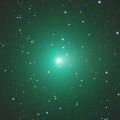
|
It brightened up to 7.3 mag in November (Nov. 7, Marco Goiato). Now it is fading. But it is bright as 9.8 mag still now (Dec. 17, Osamu Miyazaki). In the Northern Hemisphere, it stays observable in excellent condition for a long time. In the Southern Hemisphere, it stays locating extremely low after this.
Date(TT) R.A. (2000) Decl. Delta r Elong. m1 Best Time(A, h)
Jan. 2 5 13.93 45 43.9 0.684 1.612 150 10.2 22:25 (180, 9)
Jan. 9 5 15.50 47 12.0 0.773 1.674 144 10.7 22:00 (180, 8)
|

|
It brightened very rapidly in early December. Now it is very bright as 11.8 mag (Dec. 14, Alan Hale). In addition, Michael Jager observed two more components of 16.5-17.5 mag. It stays observable for a long time in this apparition.
Date(TT) R.A. (2000) Decl. Delta r Elong. m1 Best Time(A, h)
Jan. 2 22 50.96 -8 12.3 0.601 0.853 59 11.1 21:03 ( 92, 17)
Jan. 9 23 41.30 -7 29.6 0.559 0.895 64 11.2 21:01 ( 97, 22)
|
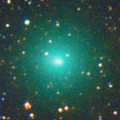
|
It brightened up to 8.2 mag in autumn (Oct. 13, Chris Wyatt). Now it is fading. But it is bright as 10.7 mag still now (Dec. 14, Seiichi Yoshida). It stays observable in the evening low sky while it will be getting fainter gradually, until early January in the Southern Hemisphere, or late February in the Northern Hemisphere.
Date(TT) R.A. (2000) Decl. Delta r Elong. m1 Best Time(A, h)
Jan. 2 22 17.46 -13 48.1 2.166 1.706 49 11.5 21:03 ( 83, 13)
Jan. 9 22 36.12 -11 51.2 2.254 1.749 47 11.8 21:01 ( 83, 11)
|

|
Now it is bright as 11.9 mag (Dec. 3, Ken-ichi Kadota). It stays 12 mag until March. In the Southern Hemisphere, it stays observable in good condition after this. In the Northern Hemisphere, it will never be observable after this.
Date(TT) R.A. (2000) Decl. Delta r Elong. m1 Best Time(A, h)
Jan. 2 14 31.42 -42 59.3 2.095 1.753 56 11.7 3:04 (301, 36)
Jan. 9 14 39.64 -48 24.2 2.037 1.777 60 11.7 3:12 (307, 42)
|
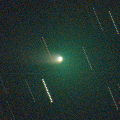
|
Brightened rapidly. Now it is very bright as 10.3 mag (Dec. 15, Carlos Labordena). In the Northern Hemisphere, it stays observable in good condition for a long time. In the Southern Hemisphere, it locates extremely low after this.
Date(TT) R.A. (2000) Decl. Delta r Elong. m1 Best Time(A, h)
Jan. 2 1 13.92 26 52.5 0.815 1.431 105 12.0 21:03 (144, 18)
Jan. 9 1 32.87 29 43.3 0.880 1.462 103 12.5 21:01 (144, 14)
|

|
First return of a new periodic comet which brightened up to 13 mag in 2009. Now it is bright as 12.4 mag (Dec. 14, Seiichi Yoshida). It stays 12 mag until January, and it is observable in excellent condition.
Date(TT) R.A. (2000) Decl. Delta r Elong. m1 Best Time(A, h)
Jan. 2 4 47.08 0 26.0 0.382 1.308 142 12.2 21:59 (180, 54)
Jan. 9 4 56.80 4 42.9 0.395 1.315 141 12.4 21:41 (180, 50)
|
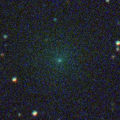
|
Brightened rapidly. Now it is very bright as 12.3 mag (Dec. 21, Ken-ichi Kadota). It will approach to Earth down to 0.46 a.u. in April, and it is expected to brighten up to 9 mag and to be observable in excellent condition. It will be unobservable temporarily from January to February.
Date(TT) R.A. (2000) Decl. Delta r Elong. m1 Best Time(A, h)
Jan. 2 21 16.14 -18 51.0 2.109 1.409 34 12.6 21:03 ( 70, 4)
Jan. 9 21 11.30 -18 6.8 2.147 1.337 26 12.4 21:01 ( 66, -3)
|
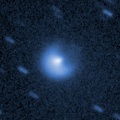
|
Now it is 13.3 mag (Dec. 19, Toshihiko Ikemura, Hirohisa Sato).
Date(TT) R.A. (2000) Decl. Delta r Elong. m1 Best Time(A, h)
Jan. 2 2 14.55 24 21.8 5.327 5.847 117 13.4 21:03 (155, 26)
Jan. 9 2 14.82 24 10.2 5.430 5.849 110 13.4 21:01 (149, 24)
|
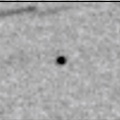
|
It will brighten up to 11.5 mag in spring. However, the condition is very bad in this apparition. It will appear in the morning low sky in March in the Southern Hemisphere, or in June in the Northern Hemisphere.
Date(TT) R.A. (2000) Decl. Delta r Elong. m1 Best Time(A, h)
Jan. 2 17 53.55 -18 45.7 2.582 1.644 13 14.2 3:04 (304,-12)
Jan. 9 18 15.34 -19 9.0 2.535 1.610 15 13.9 3:12 (302,-10)
|
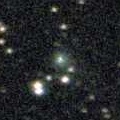
|
Now it is 13.2 mag (Dec. 12, Toshihiko Ikemura, Hirohisa Sato). It will brighten up to 11 mag in winter in 2022. In the Northern Hemisphere, it stays observable in good condition for a long time. In the Southern Hemisphere, it is not observable until 2021 November.
Date(TT) R.A. (2000) Decl. Delta r Elong. m1 Best Time(A, h)
Jan. 2 0 11.90 56 51.8 4.516 4.849 104 14.0 21:03 (153,-13)
Jan. 9 0 18.46 56 1.9 4.540 4.810 99 14.0 21:01 (150,-14)
|
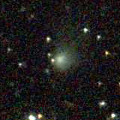
|
Now it is 13.8 mag (Dec. 22, Toshihiko Ikemura, Hirohisa Sato). It is expected to be observable at 5-6 mag for a long time from 2022 to 2023. In the Northern Hemisphere, it is not observable at the high light from 2022 summer to 2023 summer. In the Southern Hemisphere, it is not observable now. But it will be observable in good condition at the high light.
Date(TT) R.A. (2000) Decl. Delta r Elong. m1 Best Time(A, h)
Jan. 2 17 53.33 35 6.1 7.880 7.431 59 14.2 3:04 (252,-42)
Jan. 9 17 57.60 35 2.5 7.811 7.376 60 14.1 3:12 (249,-36)
|
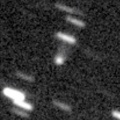
|
Now it is 14.8 mag (May 14, Toshiyuki Takahashi). It will brighten up to 13 mag from spring to summer. In the Southern Hemisphere, it stays observable in good condition for a long time. In the Northern Hemisphere, it is not observable until July in 2022.
Date(TT) R.A. (2000) Decl. Delta r Elong. m1 Best Time(A, h)
Jan. 2 16 21.01 -46 44.1 4.641 3.916 38 14.3 3:04 (314, 20)
Jan. 9 16 32.05 -48 6.6 4.561 3.892 42 14.2 3:12 (313, 24)
|
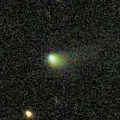
|
It stays 13-14 mag from 2020 to 2021. Appearing in the moring sky. It will be observable in good condition after this in the Southern Hemisphere. It locates somewhat low in the Northern Hemisphere.
Date(TT) R.A. (2000) Decl. Delta r Elong. m1 Best Time(A, h)
Jan. 2 16 48.42 -19 5.4 3.702 2.878 28 14.3 3:04 (294, 0)
Jan. 9 17 0.23 -19 42.0 3.651 2.874 32 14.3 3:12 (291, 4)
|

|
It had been observed as 8-9 mag for a long time in 2020. Now it is fading. Appearing in the moring sky. It will be observable in good condition after this in the Southern Hemisphere. It locates extremely low after this in the Northern Hemisphere.
Date(TT) R.A. (2000) Decl. Delta r Elong. m1 Best Time(A, h)
Jan. 2 16 52.82 -26 25.9 4.241 3.392 26 14.4 3:04 (300, 3)
Jan. 9 17 0.39 -27 24.5 4.252 3.459 32 14.5 3:12 (297, 9)
|
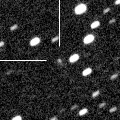
|
Now it is 15.8 mag (Dec. 3, Ken-ichi Kadota). It will brighten up to 13.5 mag from winter to spring. In the Northern Hemisphere, it stays observable in excellent condition. In the Southern Hemisphere, it stays extremely low until spring.
Date(TT) R.A. (2000) Decl. Delta r Elong. m1 Best Time(A, h)
Jan. 2 0 13.92 33 16.3 1.256 1.665 95 14.7 21:03 (137, 5)
Jan. 9 0 30.33 31 40.1 1.246 1.607 91 14.5 21:01 (135, 5)
|
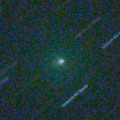
|
It brightened very rapidly up to 12.5 mag in early December (Dec. 7, Michael Jager). Now it is fading. It has already faded down to 15.9 mag (Dec. 21, Toshihiko Ikemura, Hirohisa Sato). It stays observable in excellent condition for a while.
Date(TT) R.A. (2000) Decl. Delta r Elong. m1 Best Time(A, h)
Jan. 2 2 19.22 6 18.3 0.745 1.447 112 15.0 21:03 (148, 43)
Jan. 9 2 38.30 6 7.7 0.804 1.470 110 15.4 21:01 (146, 43)
|
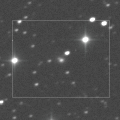
|
Now it is 14.9 mag (Oct. 10, Chris Wyatt). It will brighten up to 13.5 mag in spring. In the Southern Hemisphere, it stays observable in good condition for a long time, although it became unobservable temporarily in December. In the Northern Hemisphere, it is not observable until spring.
Date(TT) R.A. (2000) Decl. Delta r Elong. m1 Best Time(A, h)
Jan. 2 17 41.60 -42 24.0 4.375 3.500 24 15.1 3:04 (319, 6)
Jan. 9 17 44.45 -42 0.0 4.317 3.482 28 15.1 3:12 (315, 10)
|

|
Now it is 15.8 mag (Nov. 5, Ken-ichi Kadota). It will be unobservable soon.
Date(TT) R.A. (2000) Decl. Delta r Elong. m1 Best Time(A, h)
Jan. 2 21 13.79 -14 38.8 2.845 2.115 34 15.2 21:03 ( 73, 1)
Jan. 9 21 27.90 -12 54.2 2.880 2.106 31 15.1 21:01 ( 73, -2)
|

|
Now it is 15.0 mag (Nov. 15, Chris Wyatt). It stays 14-15 mag until the end of 2021. In the Southern Hemisphere, it stays observable in good condition for a long time. In the Northern Hemisphere, it is not observable until June.
Date(TT) R.A. (2000) Decl. Delta r Elong. m1 Best Time(A, h)
Jan. 2 20 44.13 -55 56.5 5.097 4.378 39 15.2 21:03 ( 35, 20)
Jan. 9 20 56.72 -54 37.9 5.113 4.370 37 15.2 21:01 ( 35, 18)
|
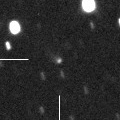
|
Now it is 15.9 mag (Nov. 10, Toshihiko Ikemura, Hirohisa Sato). It will stay at 14 mag for a long time from 2021 to 2022. In the Northern Hemisphere, it stays observable in good condition while brightening gradually, although it became unobservable temporarily in December. In the Southern Hemisphere, it is not observable until February.
Date(TT) R.A. (2000) Decl. Delta r Elong. m1 Best Time(A, h)
Jan. 2 18 1.19 4 58.9 6.335 5.509 30 15.4 3:04 (286,-29)
Jan. 9 18 4.55 4 31.4 6.291 5.487 32 15.4 3:12 (281,-23)
|
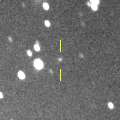
|
Now it is 15.4 mag (Dec. 3, Ken-ichi Kadota). It is expected to brighten up to 13 mag in 2022. It is observable in excellent condition in the Southern Hemisphere. In the Northern Hemisphere, it is observable from autumn to winter, but it locating extremely low.
Date(TT) R.A. (2000) Decl. Delta r Elong. m1 Best Time(A, h)
Jan. 2 8 26.23 -40 20.1 5.526 5.978 112 15.5 1:40 ( 0, 85)
Jan. 9 8 23.37 -40 34.2 5.449 5.940 115 15.4 1:10 ( 0, 84)
|

|
Now it is 14.5 mag (Dec. 21, Toshihiko Ikemura, Hirohisa Sato). In the Northern Hemisphere, it stays observable for a long time while it is getting fainter slowly. In the Southern Hemisphere, it will never be observable again.
Date(TT) R.A. (2000) Decl. Delta r Elong. m1 Best Time(A, h)
Jan. 2 16 23.52 60 5.8 4.904 4.973 88 15.5 3:04 (216,-34)
Jan. 9 16 28.35 60 28.7 4.927 5.019 89 15.6 3:12 (215,-30)
|

|
It approached to Sun down to 0.29 a.u. on July 3, and it brightened up to 0.6 mag (Alan Hale). Now it is fading. It has been already fainter than 15.0 mag (Oct. 12, Mitsunori Tsumura). Appearing in the morning sky.
Date(TT) R.A. (2000) Decl. Delta r Elong. m1 Best Time(A, h)
Jan. 2 16 27.61 -23 15.4 4.049 3.265 32 15.7 3:04 (294, 6)
Jan. 9 16 31.44 -23 44.6 4.062 3.354 38 15.9 3:12 (291, 12)
|

|
Now it is 16.3 mag (Nov. 9, Toshihiko Ikemura, Hirohisa Sato). It will brighten up to 14.5 mag from spring to summer. In the Southern Hemisphere, it stays observable in excellent condition for a long time. In the Northern Hemisphere, it is not observable after this.
Date(TT) R.A. (2000) Decl. Delta r Elong. m1 Best Time(A, h)
Jan. 2 21 32.17 -34 32.2 3.610 2.888 37 15.9 21:03 ( 59, 16)
Jan. 9 21 37.92 -35 9.6 3.639 2.860 32 15.8 21:01 ( 56, 12)
|
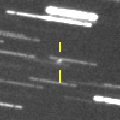
|
First return of a new periodic comet which brightened up to 17 mag in 2013. Now it is 16.6 mag (Dec. 12, Toshihiko Ikemura, Hirohisa Sato). It stays 16 mag until January.
Date(TT) R.A. (2000) Decl. Delta r Elong. m1 Best Time(A, h)
Jan. 2 12 54.68 14 57.9 0.477 1.128 94 15.9 3:04 (229, 24)
Jan. 9 13 12.48 11 4.9 0.485 1.142 96 16.0 3:12 (228, 29)
|

|
Tiny comet of Kreutz group. It was visible at 5 mag on the ground at the total eclipse on Dec. 14. It is observable in the Southern Hemisphere. But it must have already disappeared.
Date(TT) R.A. (2000) Decl. Delta r Elong. m1 Best Time(A, h)
Jan. 2 16 53.41 -69 21.5 0.567 0.752 49 16.0 3:04 (337, 27)
Jan. 9 2 53.89 -88 3.3 0.556 0.937 68 16.9 21:01 ( 1, 38)
|

|
Five apparitions of this comet was confirmed in 1999, 2004, 2008, 2012 and 2016. It will approach to Sun down to 0.04 a.u. on Jan. 17. It may be observed on the ground in December and February.
Date(TT) R.A. (2000) Decl. Delta r Elong. m1 Best Time(A, h)
Jan. 2 15 58.11 -21 43.9 0.893 0.642 39 17.8 3:04 (289, 11)
Jan. 9 17 28.00 -24 19.6 0.871 0.431 25 16.0 3:12 (298, 3)
|
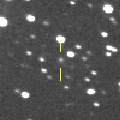
|
It brightened rapidly and became brighter than expected. Now it is 15.8 mag (Dec. 21, Toshihiko Ikemura, Hirohisa Sato). It is observable in good condition in the Northern Hemisphere. It locates somewhat low in the Southern Hemisphere.
Date(TT) R.A. (2000) Decl. Delta r Elong. m1 Best Time(A, h)
Jan. 2 2 35.72 27 48.0 1.182 1.905 122 16.1 21:03 (162, 25)
Jan. 9 2 44.73 26 29.4 1.239 1.906 117 16.1 21:01 (157, 25)
|

|
It approached to Sun down to 0.14 a.u. on Dec. 7, and it must have brightened up to 11 mag. But it was not observable at the high light. In the Northern Hemisphere, it is observable in the evening low sky from January to February. It is not observable in the Southern Hemisphere.
Date(TT) R.A. (2000) Decl. Delta r Elong. m1 Best Time(A, h)
Jan. 2 20 54.05 -4 25.3 1.301 0.754 35 16.1 21:03 ( 79, -9)
Jan. 9 21 32.60 -0 25.9 1.409 0.889 38 16.5 21:01 ( 84, -9)
|

|
First return of a new periodic comet which brightened up to 14-15 mag in 2006. Now it is 17.1 mag (Dec. 19, Toshihiko Ikemura, Hirohisa Sato). It will brighten up to 15-16 mag from February to March, and will be observable in good condition.
Date(TT) R.A. (2000) Decl. Delta r Elong. m1 Best Time(A, h)
Jan. 2 11 48.44 1 35.5 1.250 1.777 104 16.4 3:04 (223, 44)
Jan. 9 12 2.53 1 54.2 1.184 1.767 108 16.1 3:12 (217, 47)
|
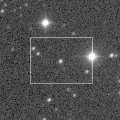
|
Now it is 15.7 mag (Dec. 8, Toshihiko Ikemura, Hirohisa Sato). It will be fading after this, and will be fainter than 18 mag in April. In the Northern Hemisphere, it stays observable in good condition for a long time after this. In the Southern Hemisphere, it will be unobservable in January.
Date(TT) R.A. (2000) Decl. Delta r Elong. m1 Best Time(A, h)
Jan. 2 23 42.95 8 58.3 1.103 1.321 78 16.3 21:03 (115, 17)
Jan. 9 0 0.16 13 36.6 1.156 1.341 77 16.4 21:01 (117, 12)
|
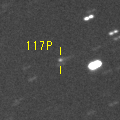
|
Now it is 17.2 mag (Dec. 20, Toshihiko Ikemura, Hirohisa Sato). It will brighten up to 13 mag in 2022. In 2021, it is observable at 15-16 mag in good condition.
Date(TT) R.A. (2000) Decl. Delta r Elong. m1 Best Time(A, h)
Jan. 2 13 28.88 -1 59.4 3.952 3.908 80 16.6 3:04 (250, 30)
Jan. 9 13 33.21 -2 18.7 3.831 3.892 86 16.5 3:12 (244, 36)
|
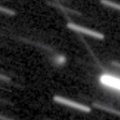
|
Now it is 16.4 mag (Dec. 17, Toshihiko Ikemura, Hirohisa Sato). It is observable at 16.5-17 mag from 2020 to 2021. In the Southern Hemisphere, it is not observable until summer in 2021
Date(TT) R.A. (2000) Decl. Delta r Elong. m1 Best Time(A, h)
Jan. 2 22 13.87 49 42.9 5.957 5.961 85 16.6 21:03 (136,-23)
Jan. 9 22 17.42 48 28.6 6.034 5.958 80 16.6 21:01 (133,-25)
|

|
Now it is 16.6 mag (Dec. 22, Toshihiko Ikemura, Hirohisa Sato). It is expected to brighten up to 14 mag from spring to summer, and it stays observable in good condition for a long time.
Date(TT) R.A. (2000) Decl. Delta r Elong. m1 Best Time(A, h)
Jan. 2 13 11.57 25 31.0 2.748 3.001 95 17.0 3:04 (225, 13)
Jan. 9 13 20.32 25 49.5 2.619 2.946 99 16.8 3:12 (220, 17)
|

|
It brightened up to 13.8 mag in autumn in 2019 (Sept. 3, 2019, Chris Wyatt). Now it is fading slowly. It has already faded down to 17.2 mag (Dec. 8, Toshihiko Ikemura, Hirohisa Sato).
Date(TT) R.A. (2000) Decl. Delta r Elong. m1 Best Time(A, h)
Jan. 2 23 44.94 4 26.5 7.074 6.917 76 16.8 21:03 (111, 20)
Jan. 9 23 46.59 4 52.0 7.229 6.960 70 16.9 21:01 (107, 15)
|
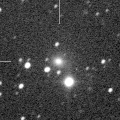
|
It brightened up to 13.5 mag in last winter (Dec. 6, 2019, Chris Wyatt). Now it is fading slowly. Now it is 17.1 mag (Dec. 19, Toshihiko Ikemura, Hirohisa Sato). In the Southern Hemisphere, it stays observable for a long time. It locates somewhat low in the Northern Hemisphere. Taras Prystavski found its fragmentation on Sept. 12.
Date(TT) R.A. (2000) Decl. Delta r Elong. m1 Best Time(A, h)
Jan. 2 1 13.40 -24 24.1 4.907 4.931 85 16.8 21:03 ( 97, 54)
Jan. 9 1 12.98 -22 56.6 5.051 4.973 79 17.0 21:01 ( 94, 48)
|
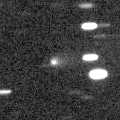
|
Now it is 16.6 mag (Dec. 27, Michael Jager). It stays observable in good condition. But it will be fading after this, and will be fainter than 18 mag in February. It locates somewhat low in the Southern Hemisphere.
Date(TT) R.A. (2000) Decl. Delta r Elong. m1 Best Time(A, h)
Jan. 2 8 29.36 20 40.1 1.583 2.517 156 16.9 1:44 (180, 34)
Jan. 9 8 22.95 21 25.3 1.591 2.555 165 17.1 1:10 (180, 34)
|
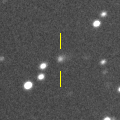
|
It brightened up to 16.1 mag in last winter (Mar. 18, Toshihiko Ikemura, Hirohisa Sato). Now it is 17.7 mag (Dec. 21, Toshihiko Ikemura, Hirohisa Sato). In 2021, it stays observable at 17 mag in good condition until summer.
Date(TT) R.A. (2000) Decl. Delta r Elong. m1 Best Time(A, h)
Jan. 2 13 7.04 -20 14.5 6.901 6.775 78 17.0 3:04 (265, 45)
Jan. 9 13 9.44 -20 22.1 6.801 6.786 84 17.0 3:12 (259, 51)
|

|
It stays observable at 16-17 mag from 2021 to 2022.
Date(TT) R.A. (2000) Decl. Delta r Elong. m1 Best Time(A, h)
Jan. 2 14 15.61 -27 40.4 5.566 5.169 61 17.4 3:04 (282, 34)
Jan. 9 14 19.34 -27 27.3 5.441 5.146 67 17.3 3:12 (279, 40)
|
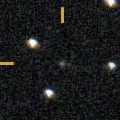
|
Now it is 17.0 mag (Dec. 9, Toshihiko Ikemura, Hirohisa Sato). It is observable at 17-18 mag for a long time from late 2019 to early 2021. It will fade out before it passes the perihelion.
Date(TT) R.A. (2000) Decl. Delta r Elong. m1 Best Time(A, h)
Jan. 2 5 31.85 18 23.4 3.522 4.464 161 17.5 22:43 (180, 37)
Jan. 9 5 28.06 18 40.5 3.554 4.455 153 17.5 22:11 (180, 36)
|

|
Now it is 17.9 mag (Nov. 19, Giuseppe Pappa). It is expected to brighten up to 12 mag in 2022. In the Southern Hemisphere, it stays observable in good condition for a long time. In the Northern Hemisphere, it locates extremely low until mid February, then it becomes unobservable until 2022.
Date(TT) R.A. (2000) Decl. Delta r Elong. m1 Best Time(A, h)
Jan. 2 3 2.83 -49 50.8 6.269 6.372 91 17.5 21:03 ( 28, 73)
Jan. 9 2 57.33 -49 24.9 6.285 6.322 87 17.5 21:01 ( 40, 69)
|

|
First return of a new periodic comet which brightened up to 17.5 mag in 2012. Now it is 17.9 mag (Dec. 9, Toshihiko Ikemura, Hirohisa Sato). It stays observable at 17 mag in good condition from summer to winter. It locates low in the Southern Hemisphere.
Date(TT) R.A. (2000) Decl. Delta r Elong. m1 Best Time(A, h)
Jan. 2 4 28.97 37 46.8 1.785 2.660 146 17.6 21:40 (180, 17)
Jan. 9 4 26.43 37 19.2 1.858 2.684 139 17.8 21:10 (180, 18)
|
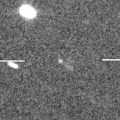
|
Now it is 18.2 mag (Nov. 23, Toshihiko Ikemura, Hirohisa Sato). It is expected to brighten up to 10 mag in 2023. In the Northern Hemisphere, it stays observable in good condition until 2023 autumn. In the Southern Hemipshere, it stays extremely low until mid July, then it becomes unobservable for a while. But it becomes observable in good condition after 2023 summer.
Date(TT) R.A. (2000) Decl. Delta r Elong. m1 Best Time(A, h)
Jan. 2 13 20.07 26 55.4 8.144 8.271 93 17.7 3:04 (226, 11)
Jan. 9 13 20.32 27 35.1 7.990 8.220 100 17.7 3:12 (219, 15)
|
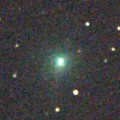
|
It approached to Sun down to 0.34 a.u. on Oct. 20. Then the nucleus was disintegrated. After the perihelion passage, it was observed at 12.5 mag (Oct. 28, Michael Jager). Now only the remnant tail is visible. In the Northern Hemisphere, it stays observable while the comet will be fading rapidly. In the Southern Hemipshere, it will never be observable again.
Date(TT) R.A. (2000) Decl. Delta r Elong. m1 Best Time(A, h)
Jan. 2 15 37.20 5 46.0 2.014 1.661 55 17.7 3:04 (263, -1)
Jan. 9 15 43.05 5 48.6 2.049 1.778 60 18.1 3:12 (259, 5)
|

|
Now it is 17.7 mag (Nov. 3, ATLAS-HKO, Haleakala). Although it is an asteroid, it is brightening rapidly. It may brighten up to 11 mag in 2023. In the Northern Hemisphere, it stays observable in good condition for a long time. In the Southern Hemisphere, it is not observable now. It will appear in mid March, but it stays extremely low after that.
Date(TT) R.A. (2000) Decl. Delta r Elong. m1 Best Time(A, h)
Jan. 2 18 18.44 36 44.5 8.081 7.640 60 17.8 3:04 (252,-48)
Jan. 9 18 21.24 36 51.8 8.028 7.595 60 17.7 3:12 (249,-41)
|
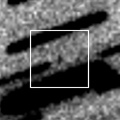
|
Now it is 19.0 mag (Dec. 22, Toshihiko Ikemura, Hirohisa Sato). It will brighten up to 11 mag from May to August. In the Southern Hemisphere, it stays observable in excellent condition for a long time. In the Northern Hemisphere, it stays observable in good condition for a while. But it becomes extremely low after July.
Date(TT) R.A. (2000) Decl. Delta r Elong. m1 Best Time(A, h)
Jan. 2 14 3.83 11 28.2 2.012 2.047 77 18.0 3:04 (245, 14)
Jan. 9 14 19.00 11 1.9 1.894 1.993 81 17.8 3:12 (242, 18)
|
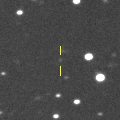
|
Now it is 18.2 mag (Dec. 17, Toshihiko Ikemura, Hirohisa Sato). It stays 17-18 mag for a long time from 2021 to 2023.
Date(TT) R.A. (2000) Decl. Delta r Elong. m1 Best Time(A, h)
Jan. 2 11 12.83 9 14.4 4.505 5.013 115 18.0 3:04 (208, 42)
Jan. 9 11 12.82 9 17.7 4.400 5.005 123 17.9 3:12 (197, 44)
|
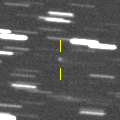
|
Now it is 17.0 mag (Dec. 27, Michael Jager). It stays observable in good condition for a while, but it will be fading after this.
Date(TT) R.A. (2000) Decl. Delta r Elong. m1 Best Time(A, h)
Jan. 2 7 37.59 23 13.4 1.377 2.350 169 17.9 0:53 (180, 32)
Jan. 9 7 30.98 24 8.5 1.400 2.382 176 18.0 0:19 (180, 31)
|
|
![]()
 323P/SOHO
323P/SOHO 277P/LINEAR
277P/LINEAR (3200) Phaethon
(3200) Phaethon 409P/2020 V1 ( LONEOS-Hill )
409P/2020 V1 ( LONEOS-Hill ) 162P/Siding Spring
162P/Siding Spring 117P/Helin-Roman-Alu 1
117P/Helin-Roman-Alu 1 C/2019 T3 ( ATLAS )
C/2019 T3 ( ATLAS ) C/2020 T2 ( Palomar )
C/2020 T2 ( Palomar ) C/2017 B3 ( LINEAR )
C/2017 B3 ( LINEAR ) C/2018 F4 ( PanSTARRS )
C/2018 F4 ( PanSTARRS ) 84P/Giclas
84P/Giclas C/2019 C1 ( ATLAS )
C/2019 C1 ( ATLAS ) C/2020 H6 ( ATLAS )
C/2020 H6 ( ATLAS ) 173P/Mueller 5
173P/Mueller 5 C/2020 R7 ( ATLAS )
C/2020 R7 ( ATLAS ) 397P/2020 M2 ( Lemmon )
397P/2020 M2 ( Lemmon ) C/2020 V2 ( ZTF )
C/2020 V2 ( ZTF ) C/2020 P1 ( NEOWISE )
C/2020 P1 ( NEOWISE ) A/2019 U5
A/2019 U5 7P/Pons-Winnecke
7P/Pons-Winnecke 99P/Kowal 1
99P/Kowal 1 178P/Hug-Bell
178P/Hug-Bell![]()












































